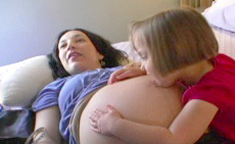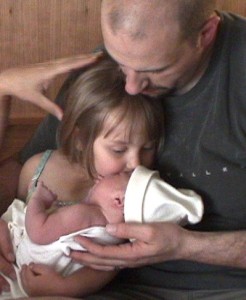February 26, 2013
Parents' Singing to Fetus and Newborn Enhances Their Well-being, Parent-Infant Attachment, & Soothability: Part Two
By: Penny Simkin, PT, CD(DONA), CCE | 0 Comments
Regular contributor Penny Simkin discusses the research around parents' singing to their babies in utero and the post birth benefits. She also shares how birth professionals can encourage clients, patients and students to start this practice during pregnancy. Part one of this two part series can be found here. - Sharon Muza, Community Manager, Science & Sensibility
______________________
What is the research evidence for postnatal benefits to parents or babies of singing to the baby before birth?
¢ Fetuses can sense audio vibrations and rhythms early in pregnancy. Later in pregnancy they hear and distinguish various sounds. (4)
¢ They recognize their parents' voices after birth (1)
¢ Newborns prefer their parents' voices over the voices of strangers (1)
¢ Repetitive prenatal reading of one story by one parent every day for weeks results in the newborn's recognition of and preference for that story. (2)
¢ Fetuses respond to music by calming, becoming active, changes in FHR (depending on the music) 5,6)
¢ Premature babies are calmed by calming music. (7)
¢ Newborns and young babies are calmed by familiar music, as demonstrated by the universal use of lullabies.
Combining these findings, a proposal
In light of all that has been learned about babies, I think we can combine it all into a simple approach to enhance bonding, soothe the baby, empower parents with their own unique tool that no one else, even the experts, can do as well as they. (8) I propose that we who provide care and education for expectant parents urge them to do the following at around 30-32 weeks' gestation (or earlier or later):
Simple steps to singing to the baby in utero and after birth
- Choose a song that you like and is easy for you to sing. It might be a lullaby or a children's song, but it does not have to be. It can be one of your favorite songs or a popular song of the day.
- Sing it every day. Both parents can sing it together, but each of you should also sing it alone much of the time. It can be played with a musical instrument some of the time, but it also should be played without an instrument much of the time.
- When your baby is born, after the initial lung-clearing cry, sing the song to your baby. The baby can be in your arms or with a nurse in the warmer. If your baby is crying, try to sing close to his/her ear or loud enough that he/she can hear it at least during the pauses to take a breath.
- Continue singing it every day, especially during times when your baby is crying (and has been fed; don't use it as a substitute for feeding!)
- Sing it when bathing or diapering your baby, when soothing or helping your baby go to sleep.
- Sing it when your baby is upset and you can't pick her up, such as when driving in the car and you can't stop or take the baby out of the car seat; or at a checkup if the doctor is doing something painful.

Maia sings to her sister in utero
©Penny Simkin
If parents feel they can't sing or are too embarrassed to do it, I suggest choosing a poem that has a nice rhythmic meter, and recite that to the baby. I recommend Mother Goose Rhymes or poems in books by AA Milne, such as 'When We Were Very Young' and 'Now We Are Six;' or Shel Silverstein's 'Where the Sidewalk Ends' and others.
Film clips showing baby's reactions to familiar songs
Recent students in my birth class took my suggestion to heart, singing 'Las MaÃnitas,' from their Mexican culture, to their unborn baby frequently. The dad would lie with his head on the mother's pregnant belly as they sang.They even videotaped sessions while the mother was having a non-stress test that showed the baby's heart rate steadying when the dad was singing, and rising when he was not. We also see the dad singing to their sweet little daughter right after the birth. Though she cries pretty hard when being suctioned and rubbed with blanket, she calms down with his singing.
I've just completed a film for children (9). In the film, we see 4 year old Maia singing 'Twinkle, Twinkle, Little Star' to her baby sister before birth and again right after birth. Neve, her sister, calms down when she hears Maia singing the familiar song.
Conclusion

Maia sings to her newborn sister
©Penny Simkin
In conclusion, when parents sing one (or possibly a few) songs repeatedly to their child, before and after birth, it is a once in a lifetime opportunity to build a unique, meaningful and fun connection with their baby. The child already knows and loves the song as sung by his/her parents more than any other song, sung by anyone else. Parents always have their voice with them and can use it to comfort, soothe, and play with their child for years to come. Parents have the opportunity prenatally to give their baby a gift that becomes a gift for them as well.
Singing to the baby before and after birth is a lovely and very special thing to do. Would you consider introducing this ritual to your students, clients and patients? Have you already done so? How has it been received? Do you have any stories about parents who have practiced this connection? Please share in the comments section, I would love to hear about it. If we all get the word out to expectant families, it could have a very positive impact.
References:
- Brazelton B. Cramer B. (1991)The Earliest Relationship: Parents, Infants, and The Drama Of Early Attachment . Da Capo Press Cambridge, MA.
- De Casper A. 1974, as described in Klaus M, Klaus P, Kennell J. 2000. Your Amazing Newborn. Da Capo Press, Cambridge, MA..
- Odent M. 1984, Birth Reborn. Pantheon Books: New York
- Klaus M, Klaus P, Kennell J. 2000, Your Amazing Newborn. Da Capo Press, Cambridge, MA.
- Verny T, Kelly J. (1982) The Secret Life of the Unborn Child. Dell: NY
- Chamberlain D. (2013) Windows to the Womb. North Atlantic Books: Berkeley, CA.
- Lubitzky R, Mimouri F, Dollberg S, Reifen R, Ashbel G, Mandel D. 2010. Effect of music by Mozart on energy expenditure in growing preterm infants. Pediatrics 126;e24-e28. DOI: 10.1542/peds.2009-0990.
- Simkin P. (2012) Singing to the baby before and after birth. International Doula 19(3):30-31
- Simkin P. (2013) 'There's a Baby: A Children's Film About New Babies.' PassionflowersProductions: Seattle.
Tags
Pregnancy Childbirth education Postpartum Penny Simkin Newborns Babies Infants Infant Attachment Singing To Baby